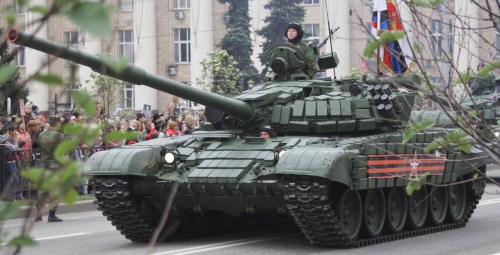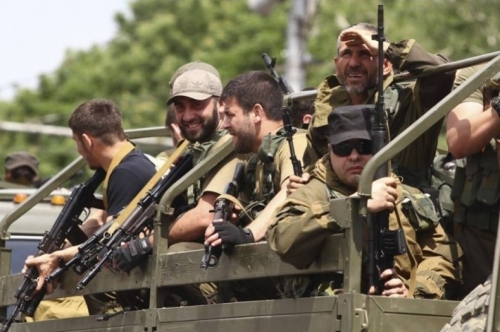Christelle Néant
Ex: https://metamag.fr
L’Ukraine poursuit l’escalade dans le Donbass et enlise le processus diplomatique
En ce triste anniversaire du 26 mai, les nouvelles du Donbass sur le front militaire comme sur le front diplomatique, sont loin d’être positives. Trois ans après l’arrivée de la guerre à Donetsk (le 26 mai 2014 avaient lieu les premiers combats touchant la capitale), l’Ukraine poursuit dans sa logique de résoudre le conflit avec la population du Donbass par la force.
Le bilan de la semaine énoncé par Edouard Bassourine, le commandant en second du commandement opérationnel de l’armée de la République Populaire de Donetsk (RPD), n’est pas pour rassurer sur l’évolution du conflit dans un futur proche.
Si le nombre de violations totales du cessez-le-feu hebdomadaires a augmenté de seulement 16 % pour atteindre 374 violations (dont 58 durant les dernières 24 heures), le nombre de bombardements quant à lui a plus que doublé par rapport à la semaine précédente avec 4 456 obus d’artillerie, de mortier, de char d’assaut, et de roquettes de lance-roquettes multiples tirés par l’armée ukrainienne sur le territoire de la RPD. Ce chiffre n’inclut pas toutes les roquettes de petit calibre, les munitions de lance-grenade, et autres tirs d’armes légères, dont le nombre est au moins équivalent à celui des armes lourdes (et plus souvent égal au double du nombre de tirs lourds).
Ces chiffres atteignent le même niveau que les pics qui avaient été observés en décembre 2016, un mois à peine avant l’escalade brutale qui avait eu lieu entre fin janvier et début février 2017, et qui avait vu le nombre de bombardements lourds hebdomadaire dépasser les 8 000 tirs.
Ces bombardements qui ont touché 31 localités de la république ont tué quatre soldats et blessé 12 personnes dont huit civils et endommagé 61 habitations dont 16 rien que durant les dernières 24 heures. Des tirs corrigés à l’aide de drones (pourtant interdits par les accords de Minsk), dont certains de fabrication américaine, qui sont venus s’écraser sur les positions de l’armée de la RPD.
Les provocations se multiplient aussi, après le tir du 13 mai 2017 dirigé contre Avdeyevka et mené de manière évidente depuis la localité de Vodyanoye aux mains de Secteur Droit, d’autres tirs semblables ont frappé Avdeyevka, toujours dans le même but : accuser la RPD d’avoir tiré délibérément sur des civils innocents.
Et pendant que l’OTAN conditionne l’amélioration des relations avec la Russie à l’arrêt de son soutien au Donbass (autant dire qu’il gèlera en enfer avant que ça arrive), Kiev continue de saboter la mise en œuvre des accords de Minsk tout en clamant sur tous les toits (surtout ceux des médias occidentaux) vouloir que ces accords soient appliqués.
Car à regarder la liste des dernières exigences en date côté ukrainien pour que ces accords soient appliqués, il faut vraiment être stupide ou de mauvaise foi pour croire qu’ils vont l’être :
– la révocation du décret du président russe sur la reconnaissance des documents d’identité produits par les républiques de Donetsk et Lougansk (cette mesure étant valable jusqu’à la résolution pacifique du conflit pour des raisons humanitaires il n’y a aucune chance ou presque pour que cela arrive),
– la révocation des décisions sur l’établissement des frontières d’état par les deux républiques (ça aussi l’Ukraine peut toujours rêver),
– l’abolition de la mise sous tutelle d’état des usines qui étaient sous juridiction ukrainienne (tant que le blocus commercial total du Donbass est appliqué, l’Ukraine peut faire une croix dessus),
– la renonciation de l’utilisation du rouble russe comme monnaie légale (là aussi tant que le blocus économique total du Donbass est appliqué, cela n’arrivera pas, car il n’y a plus assez de hryvnias en circulation ici),
– le retour du contrôle des portions de frontières commune entre les républiques et la fédération de Russie à l’Ukraine (ce point est prévu à la fin des accords de Minsk quand TOUT LE RESTE aura été mis en œuvre).

Rien qu’en regardant le dernier point on se rend bien compte que cette histoire c’est le serpent qui se mord la queue, l’Ukraine demandant d’appliquer avant tout le reste un point qui est prévu à la fin du processus de Minsk quand tout le reste aura été mis en œuvre… Autant dire que cela ne sera jamais mis en œuvre.
Pendant ce temps, un des points des accords de Minsk, l’échange des prisonniers au format « tous contre tous » piétine lui aussi. Sur ce point là aussi l’Ukraine traîne des pieds et sabote le processus, essayant de ne pas rendre certains prisonniers sous des prétextes plus ou moins bidons. Et surtout, ce qui inquiète les autorités de la RPD, c’est qu’aucune information n’est disponible pour 77 des noms que la RPD a réclamés. Daria Morozova, la médiatrice aux droits de l’homme de la RPD s’inquiète de leur sort et craint qu’ils ne soient tout simplement morts.
Une crainte justifiée, quand on regarde la dérive continue de l’Ukraine vers une dictature sauce néo-nazie. Pendant que les activistes anti-Maïdan sont condamnés à six ans de prison fermes pour avoir simplement participé à des manifestations contre les nouvelles autorités ukrainiennes, comme Iouri Apoukhtine, certains députés ukrainiens proposent de s’inspirer de la politique linguistique de l’Allemagne Nazie pendant la Seconde Guerre Mondiale (on a les références qu’on peut hein), alors que d’autres proposent très sérieusement de frapper les élèves qui parleraient russe à l’école…
Les accords de Minsk sont cliniquement morts, le Donbass ne pourra jamais retourner sous le giron d’un état ukrainien où ce genre de dérives graves n’est pas l’exception mais la règle.
Trois ans après que la guerre soit arrivée à Donetsk, il est temps que les dirigeants américains et européens cessent la ventilation artificielle qui maintient l’Ukraine en vie sur le papier, et lui permet de continuer à faire des morts dans le Donbass…





 del.icio.us
del.icio.us
 Digg
Digg
